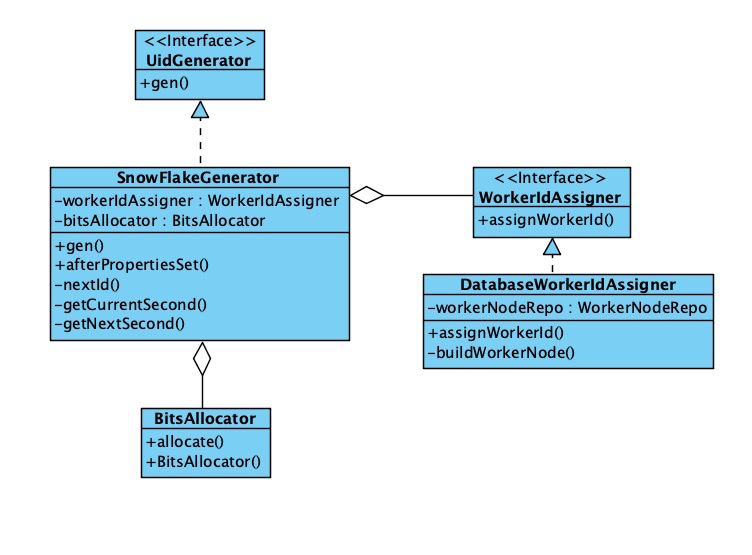背景
最近对snowflake比较感兴趣,就看了一些分布式唯一ID生成器(发号器)的开源项目的源码,例如百度的uid-generator,美团的leaf。大致看了一遍后感觉uid-generator代码写的要更好一些,十分的精炼,短小精悍。
正好手头有个任务要搞个发号器,百度的这个源码是不能直接运行起来提供服务的,为了练练手,就把百度的uid-generator迁移到spring boot上重写了一遍。
代码基本一模一样,就做了一些工程化的东西,让uid-generator能以服务的形式跑起来,通过http接口对外提供服务。
可运行的代码地址:点这里
SnowFlake数据结构
这里借用一下uid-generator的图:

这一个结构就是一个snowflake算法里的id,共计64位,就是一个long。
- sign是一个恒为0的值,是为了保证算出的id恒为正数。
- delta seconds (28 bits)
当前时间,相对于时间基点"2016-05-20"的增量值,单位:秒,最多可支持约8.7年。时间基点是自己配置的。28位即最大表示2^28的数值的秒数,换算一下就是8.7年左右。
- worker id (22 bits)
机器id,最多可支持约420w次机器启动。内置实现为在启动时由数据库分配。420w = 2^22
- sequence (13 bits)
每秒下的并发序列,13 bits可支持每秒8192个并发,即2^13个并发
这些位数都是可以改变的,对于很多公司来说,28位 delta seconds带来的8.7年的最大支持时间是可预期的不够用的,而22bit的worker id和13bit的sequence则是远远超出可预期的业务场景的,那么就可以自由的根据自己的需求,对这三个参数进行调整。
例如,{"workerBits":20,"timeBits":31,"seqBits":12}这样的配置可以68年,100W次重启,单机每秒4096个并发的情况,个人感觉还是比较合适的。
snowflake的实现有很多种方式,不过思想上都是一样的。
SnowFlake发号实现
在了解SnowFlake的数据结构后,就可以来看看具体是如何生成ID的了。
其实这个过程,就是往delta seconds,sequence,worker id三个结构里填充数据的过程。
整体类图如下:

SnowFlakeGenerator就是基于SnowFlake算法的UidGenerator的实现类,SnowFlake的实现就是在这个类里;
BitsAllocator就是对SnowFlake 的ID进行位操作的共聚类;
DatabaseWorkerIdAssigner就是一个基于DB自增的worker id 分配器的实现。
BitsAllocator
这个类是进行一些位操作的工具类,给每一个id 的delta seconds,sequence,worker id赋值就是通过这个类来实现的。这个类有以下成员变量:
/** * Total 64 bits */ public static final int TOTAL_BITS = 1 << 6; /** * Bits for [sign-> second-> workId-> sequence] */ private int signBits = 1; private final int timestampBits; private final int workerIdBits; private final int sequenceBits; /** * Max value for workId & sequence */ private final long maxDeltaSeconds; private final long maxWorkerId; private final long maxSequence; /** * Shift for timestamp & workerId */ /** * timestamp需要位移多少位 */ private final int timestampShift; /** * workerId需要位移多少位 */ private final int workerIdShift;
其他字段都好说,看名称和注释都能明白。最下面俩shift,可能现在看着有些摸不着头脑,不过看后面的赋值过程就知道什么叫“shift”了
构造器:
/** * Constructor with timestampBits, workerIdBits, sequenceBits<br> * The highest bit used for sign, so <code>63</code> bits for timestampBits, workerIdBits, sequenceBits */ public BitsAllocator(int timestampBits, int workerIdBits, int sequenceBits) { // make sure allocated 64 bits int allocateTotalBits = signBits + timestampBits + workerIdBits + sequenceBits; Assert.isTrue(allocateTotalBits == TOTAL_BITS, "allocate not enough 64 bits"); // initialize bits this.timestampBits = timestampBits; this.workerIdBits = workerIdBits; this.sequenceBits = sequenceBits; // initialize max value //-1 是111111111(64个1) //先将-1左移timestampBits位,得到111111100000(timestampBits个零) //然后取反,得到00000....1111...(timestampBits)个1 //等价于2的timestampBits次方-1 this.maxDeltaSeconds = ~(-1L << timestampBits); this.maxWorkerId = ~(-1L << workerIdBits); this.maxSequence = ~(-1L << sequenceBits); // initialize shift this.timestampShift = workerIdBits + sequenceBits; this.workerIdShift = sequenceBits; }
也很简单,重点就在 “~(-1L << timestampBits) ”这样一坨操作,可能理解起来会有些困难。这是一连串的位操作,这里进行一下分解:
-
- -1 左移 timestampBits 位,实际的二进制看起来是11111111......00000...(最前面的1是最高位,表示负数;后面有timestampBits个0)
- 对-(2^timestampBits)进行取反操作,的到了2的timestampBits次方-1。实际的二进制看起来就是1111(timestampBits个1)
这一通操作其实也就相当于2的timestampBits次方-1,也就是timestampBits位二进制最大能表示的数字,不过是用位运算来做的。如果不懂二进制的位移和取反,可以百度“位操作”补充一下基础,这里就不展开了。
分配操作:
/** * Allocate bits for UID according to delta seconds & workerId & sequence<br> * <b>Note that: </b>The highest bit will always be 0 for sign * * 这里就是把不同的字段放到相应的位上 * id的总体结构是: * sign (fixed 1bit) -> deltaSecond -> workerId -> sequence(within the same second) * deltaSecond 左移(workerIdBits + sequenceBits)位,workerId左移sequenceBits位,此时就完成了字节的分配 * @param deltaSeconds * @param workerId * @param sequence * @return */ public long allocate(long deltaSeconds, long workerId, long sequence) { return (deltaSeconds << timestampShift) | (workerId << workerIdShift) | sequence; }
这里就是对delta seconds,sequence,worker id三个结构进行赋值的地方了,核心代码之一。可以再看一下最上面的图,sequence是在最右侧(最低位),所以sequence不用做位移,直接就是在对的位置;
而workerId,需要左移workerIdShift才能到正确的位置。workerIdShift看上面的构造器,就是sequenceBits,就是sequence的位数;
deltaSeconds 左移timestampShift位,也就是workerIdBits + sequenceBits;
然后对这三个位移后的值进行“或”操作,就把正确的值赋到正确的位数上了。
DatabaseWorkerIdAssigner
SnowFlake中,deltaSeconds依赖时间戳,可以通过系统获取;sequence可以通过自增来控制;这俩字段都是项目可以自给自足的,而WorkerId则必须还有一个策略来提供。
这个策略要保证每次服务启动的时候拿到的WorkerId都能不重复,不然就有可能集群不同的机器拿到不同的workerid,会发重复的号了;
而服务启动又是个相对低频的行为,也不影响发号性能,所以可以用DB自增ID来实现。
DatabaseWorkerIdAssigner就是依赖DB自增ID实现的workerId分配器。
代码就不贴了,就是个简单的save然后取到DB的自增ID。
SnowFlakeGenerator
这里就是控制发号逻辑的地方了。
先看看成员变量和初始化部分:
@Value("${snowflake.timeBits}")
protected int timeBits = 28;
@Value("${snowflake.workerBits}")
protected int workerBits = 22;
@Value("${snowflake.seqBits}")
protected int seqBits = 13;
@Value("${snowflake.epochStr}")
/** Customer epoch, unit as second. For example 2016-05-20 (ms: 1463673600000)*/
protected String epochStr = "2016-05-20";
protected long epochSeconds = TimeUnit.MILLISECONDS.toSeconds(1463673600000L);
@Autowired
@Qualifier(value = "dbWorkerIdAssigner")
protected WorkerIdAssigner workerIdAssigner;
/** Stable fields after spring bean initializing */
protected BitsAllocator bitsAllocator;
protected long workerId;
/** Volatile fields caused by nextId() */
protected long sequence = 0L;
protected long lastSecond = -1L;
@PostConstruct
public void afterPropertiesSet() throws Exception {
bitsAllocator = new BitsAllocator(timeBits,workerBits,seqBits);
// initialize worker id
workerId = workerIdAssigner.assignWorkerId();
if(workerId > bitsAllocator.getMaxWorkerId()){
throw new RuntimeException("Worker id " + workerId + " exceeds the max " + bitsAllocator.getMaxWorkerId());
}
if (StringUtils.isNotBlank(epochStr)) {
this.epochSeconds = TimeUnit.MILLISECONDS.toSeconds(DateUtils.parseByDayPattern(epochStr).getTime());
}
log.info("Initialized bits(1, {}, {}, {}) for workerID:{}", timeBits, workerBits, seqBits, workerId);
}
@Value注入的都是配置文件里读取的值。
afterPropertiesSet里,将配置文件读取到的值传递给BitsAllocator,够造出一个对应的BitsAllocator;
然后生成一个workerId(插入一条DB记录),初始化过程就完成了。
再看核心发号控制逻辑:
/** * Get UID * * @return UID * @throws UidGenerateException in the case: Clock moved backwards; Exceeds the max timestamp */ protected synchronized long nextId() { long currentSecond = getCurrentSecond(); // Clock moved backwards, refuse to generate uid //todo 时钟回拨问题待解决 if (currentSecond < lastSecond) { long refusedSeconds = lastSecond - currentSecond; throw new UidGenerateException("Clock moved backwards. Refusing for %d seconds", refusedSeconds); } // At the same second, increase sequence //同一秒内的,seq加一 if (currentSecond == lastSecond) { //seq 加一,如果大于MaxSequence,就变成0 //如果大于MaxSequence 就是seq能取到的最大值,二进制(seqBits -1)位全是1 sequence = (sequence + 1) & bitsAllocator.getMaxSequence(); // Exceed the max sequence, we wait the next second to generate uid //号发完了,等到下一秒 if (sequence == 0) { currentSecond = getNextSecond(lastSecond); } // At the different second, sequence restart from zero } else { //新的一秒,重新开始发号 sequence = 0L; } lastSecond = currentSecond; // Allocate bits for UID return bitsAllocator.allocate(currentSecond - epochSeconds, workerId, sequence); }
注意这是个synchronized方法,这是关键。
getCurrentSecond就是获取当前以秒为单位的时间戳;
sequence计算逻辑
如果currentSecond和lastSecond一样,那说明本次发号请求不是本秒的第一次,只要将sequence直接+1即可;如果+1后大于了MaxSequence(这里会用& bitsAllocator.getMaxSequence()设置为0),那说明本秒的sequence已经用完了,此时请求已经超出了本秒系统的最大吞吐量,这里需要调用getNextSecond(详见github),来等待到下一秒;
如果currentSecond和lastSecond不一样,说名本次请求是全新的一秒,这时候sequence设置为0即可。
deltaSecond计算逻辑
就是currentSecond - epochSeconds,当前时间减去初始时间的秒数。
此时,workerId,deltaSecond,sequence都已经确定了具体的值,然后调用bitsAllocator.allocate方法,就可以生成一个全新的ID了,至此发号完成。



 浙公网安备 33010602011771号
浙公网安备 33010602011771号